1998 BUICK PARK AVENUE brake light
[x] Cancel search: brake lightPage 11 of 426

CAUSPlC
BURNS
SPARK OR ql!,
COULD
FUME
EXPLODE
BATTERY
I F
1 :
f
I
1
These symbols
are important
for you and
your passengers whenever your
vehicle
is
driver.:
DOOR LOCK
UNLOCK
POWER
WINDOW
These symbols
have to do with
your lamps:
I. These symbols i These symbols
are on some of ' are used OR
your controls: wming and
[ indicator lights: i
WEWTkATIMG
FAN
BRAKE
ANTI-LOCK (e)
BRAKES
Here xe some
other symbols
you may see:
SPEAKER
FUEL
ProCarManuals.com
Page 87 of 426
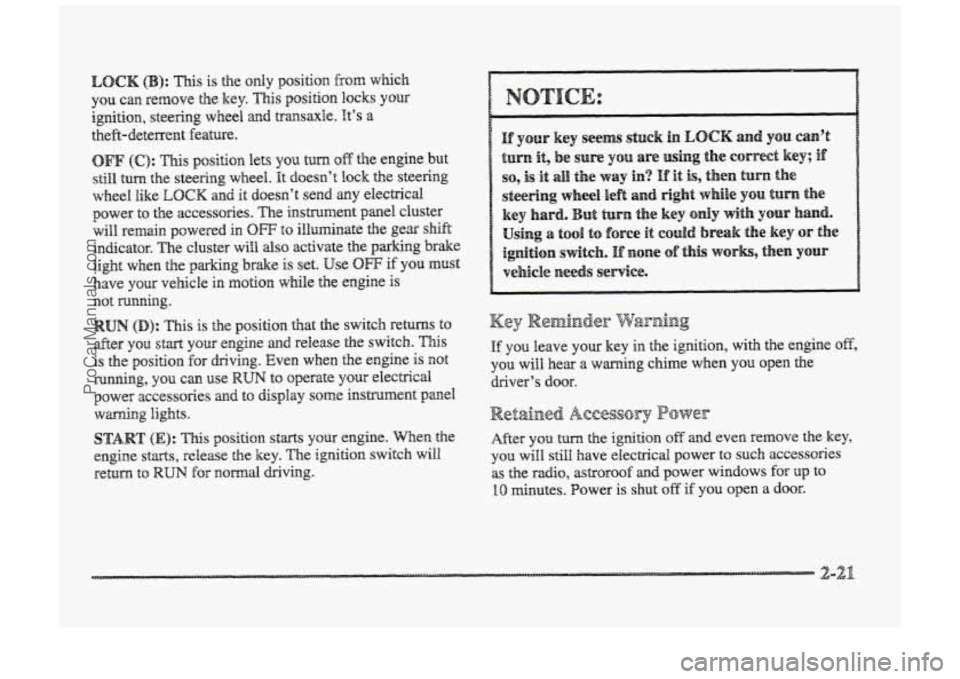
I
LOCK @I: This is the only position from which
YOU can remove the key. This position locks YOU
igition, steering wheel and transaxle. It’s a
theft-deterrent feature.
OFF (C): This position lets YOU turn ofif the engine but
still turn the steering wheel. It doesn’t lock the steering
wrlhee1 like LOCK and it doesn’t send my electrical
power to
the accessories. The instrument panel cluster
will remain powered in OFF to illarminate the gear sWt
indicator. The cluster will also activate the parking brake
fight when the parking brake is set. Use OW if you must
have your vehicle in motion while the engine is
not mnanaing.
RUN (D): This is the position that the switch returns to
after you start YSUP engine and release the switch. This
is &e p~sisi~n for driving. Even when the engine is not
running, you can use RUN to operate your electrical
power accessories anad t~ display some instrument panel
START (E): This position starts your engine. When the
engine
starts, release the key. The ignition switch will
return to RUN for ~a~rrrnal driving.
wdng
lights.
Retained Acces§ory Power
After you turn the ignition off md even remove the key,
you
will still have electrical power to such accessories
as the radio, astroroof ad power windows for up to
10 minutes. Power is shut off if you open a door.
2-21
ProCarManuals.com
Page 93 of 426
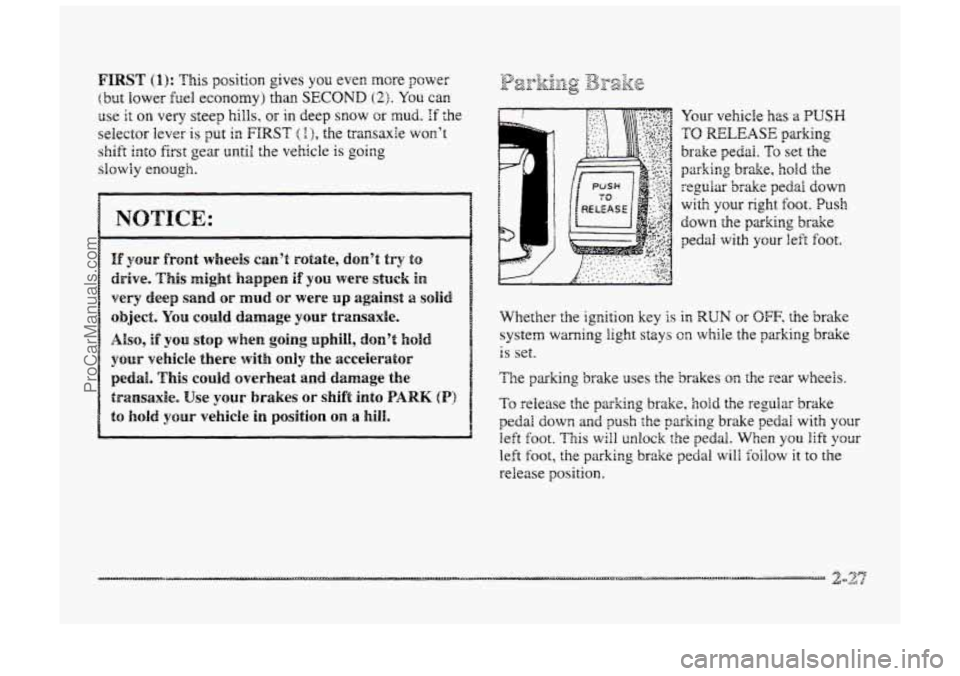
FIRST (I): This position gives you even more power
(but lower fuel economy) than SECOND (2). You can
use it on very steep hills, or in deep snow or mud. If the
selector lever is put in FIRST ( I >, the transaxle won’t
shift into first gear until the vehicle is going
slowHy enough.
If your hplrt wheels can’t rotate, don’t try to
drive. This might happen if YOU were stuck in
very deep sand OF mud or were up against a solid
object. You could damage your transaxle.
Also, if you stop when going uphill, don’t hold
your vehicIe there with only the accelerator
pedal. This could overheat and damage the
transaxle. Use ysur brakes or shift into BARK (P)
Your vehicle has a PUSH
TO RELEASE parking
brake pedai. To set the
parking brake, hold the
regular brake pedal down
with your right foot. Push
down the papking brake
pedal with your left foot.
~~ ~~
Whether the ignition key is in RUN or OFF. the brake
system
wming light stays on while the parking brake
1s set.
The parhng brake uses the brakes the rear wheels.
To release the parking brake, hoki the regular brake
pedal down and push the parking brake pedal with your
left foot. This will unlock the pedal. When you lift your
left foot, the parking brzke pedal will foilow it to the
release position.
ProCarManuals.com
Page 94 of 426
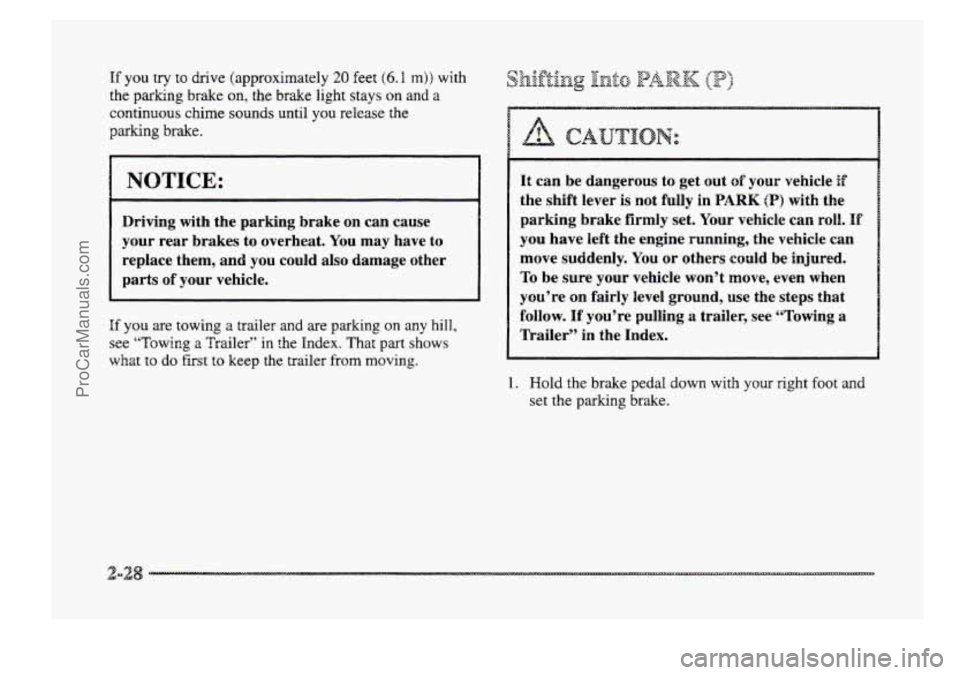
If you try to drive (approximately 20 feet (6.9 m)) with
the
parlkrng brake on, the brake light stays on and a
continuous chime sounds until you release the
parking
brake.
NOTICE:
Driving with the parking brake on can cause
your rear brakes to overheat. You may have to
replace them, and you could also damage other
parts
of your vehicle.
If you are towing a trailer and are parking on any hill,
see “Towing a Trailer” in the Index. That part shows
what
to do first to keep the trailer from moving.
It can be dangerous to get out of your vehicle if
the shift lever is not fully in PARK (P) with the
parking brake firmly set. Your vehicle can roll.
If
you have left the engine running, the vehicle can
move suddenly. You or others
could be injured.
To be sure your vehicle won’t move, even when
you’re on fairly level ground,
use the steps that
follow.
If you’re pulling a trailer, see “Towing a
Trailer” in the Index.
1. Hold the brake pedal down with your right foot and
set the parking brake.
ProCarManuals.com
Page 144 of 426

With the anti-lock brake
system, the
Iight(s) will
come on when you start
your engine and may stay
on for several seconds.
1 That’s BzorfnaI.
The anti-lock brake system warning light should come
on briefly when YOU turn the ignition key to RUN. If the
light doesn’t come on then, have it fixed SO it will be
ready
to wm you if there is a problem.
OFF
This warnirag light should
come on briefly 2s you start
the engine. If the warning
iight doesn’t corne on then,
have it fixed so it will be
ready
to warn you if there’s
a problem.
If it stays on, or comes on when you’re driving, there
may be a problem with your traction control system and
your vehicle may need service. When this warning light
is on, the system will not limit wheel spin. Adjust your
The traction control system wming light may come on
for the foIlowing reasons:
dr;ivi3g accordingly.
If yos turn the system off by pressing the button
located on the end of the shift lever, the warning
light will come on and stay on. To turn the system
back on, press the button again. The warning light
should go off. (See “Traction Control System” in the
Index
for more kf~m;ation.)
ProCarManuals.com
Page 211 of 426

Remember: Anti-lock doesn’t change the the you need
to get your foot up to the br&e pedal or always decrease
stopping distance. If you get too dose to the vehicle in
front of you, you won’t have time to apply your brakes
If that vehicle suddenly slows or stcps. Always leave
enough
room up ahead tu stop, even though yorr have
anti-lock brakes.
Don’t pump the brakes. Just hold the brake pedal down
5mly and let anti-lock work for you. You may feel a
slight brake pedal gulsation or notice some noise, but
this is normal.
?F? 5-~~l:”~p.Tp LC :~?$<:4:?~$ ,y...,iq:py; (TF &&@$B&) r ,y a% *.-blL& . ,%*i ...,‘. --’3 li Y z .i I A -2.
YQW vehicle may have a traction control system thzat
limits wheel spin. This is especially useful in slippery
road conditions. The system operates only if it senses
that one
or both of the front wheels are spinning or
beginning to lose traction. When this happens, the
system works the front brakes and reduces engine power
to limit wheel spin.
You may feel or hear the system working, but this
is nomal.
__ . ... a
See ‘‘T~-acti~m Contra1 System Warning Eight” ii: the
Irzdex. WEen this warning light is on, the system will mt
limit wheel spin. Adjust your driving zccsrdingly.
The traction COII~FO~ system arr;2smaticaily comes on
whenever you start your vehicle. To limit wheel spin,
especially in siippery road conditio~s, y3u shouEd
always leave the system on. But you can turn- the
traction control system off‘ if you ever need to. (YQQ
should turn the system off if pur vehicBe ever gets stuck
in sand, mud, ice or snow. See “Rockr~g Your Vehicle”
in the Index.)
ProCarManuals.com
Page 304 of 426
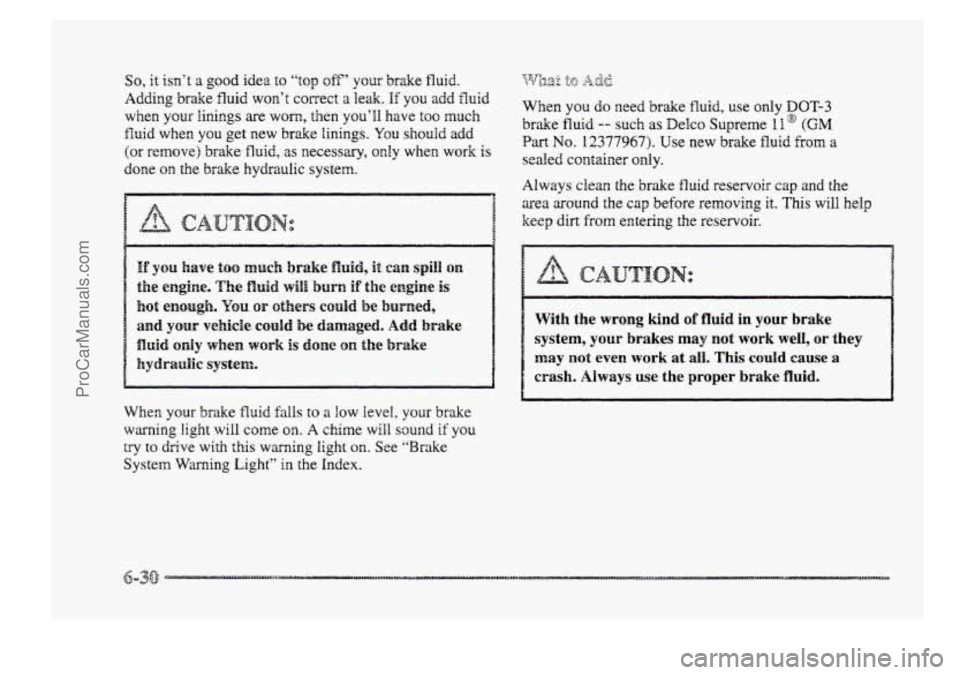
So, it isn‘t a good idea to “top oft“ your brake fluid.
Adding brake fluid won’t correct a leak. If YOU add fluid
when your linings are worn, then you’ll have loo much
fluid when you get new brake linings. You shouki add
(or remove) brake fluid, as necessary, only when work is
done
on the brake hydraulic system.
When your Srake fluid falls to a low level, your brake
warning light will come on. A chime will sound if you
try to drive with this warning light on. See “Brake
System Waning Eight” in the Index.
When you do need brake fluid, use only DOT-3
brAe fluid -- such as Delco Supreme II@ (GM
Part No. 12377967). Use new brake fluid from a
sealed container only.
Always clean the brake fluid reservoir cap and the
mea
around the cap before removing it. This will help
keep dirt from entering the reservoir.
~~ ~~
With the wrong kind of fluid in your brake
system,
your brakes may not work well, or they
may not even work at all. This could cause a
I
1 crash. Always use the proper brake fluid.
1
ProCarManuals.com
Page 306 of 426
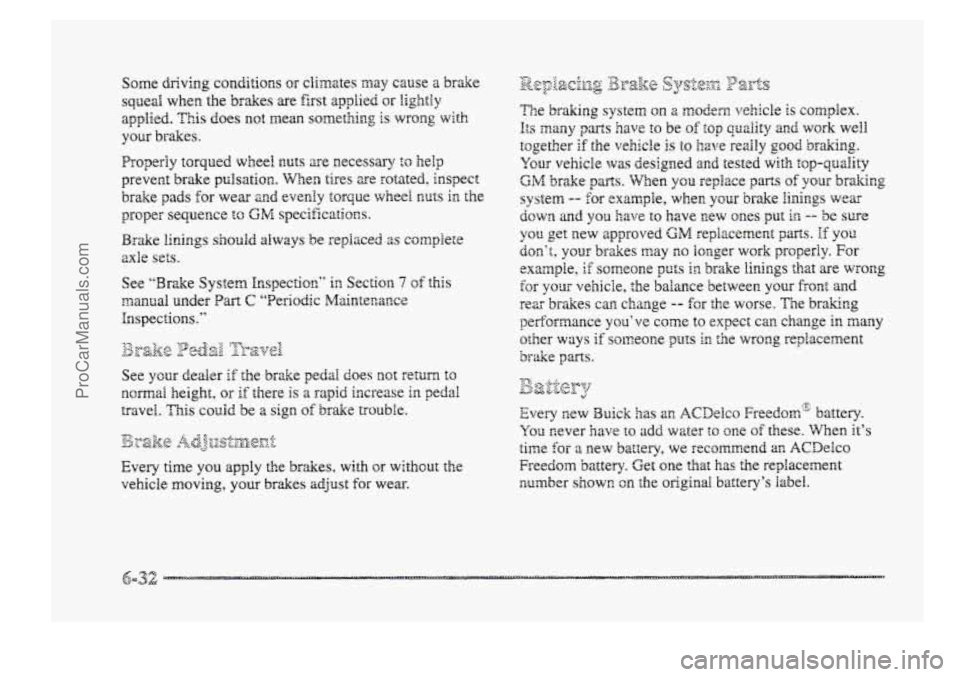
Some driving conditions or climates may cause a brake
squeal when the brakes are first applied or lightly
applied. This does not mean something is wrong with
your brakes.
Properiy
torqued whee! nuts irre necessary to heIp
prevent
brake pulsation. When tires are rotated, inspect
brake
pacts for wear and evenly torque wheel nuts in the
proper sequence to GM specifications.
Brake linings should always be replaced 2s complete
axle seis.
See "Brake System Inspectioc" in Section 7 of this
nanuai under Part C "Periodic Maintecance
Inspections."
Every time
you apply the brakes, with or wiFhcut the
vehicle moving, your brakes adjust for wear.
Tie braking system a modem vehicle is complex.
Its many parts have to be of top quality and work weII
together if the vehicle is io lxwe reakly good braking.
Your vehicle \vas designed and tested with top-quality
GM brake puts. When you replace parts of your braking
system
-- for example, when your brake kings wear
down and you have to Rave new ones put irn -- be sure
you get new approved GM replacement parts. If YOQ
don't, your brakes may no ionger work properly. For
example,
if someone puts in brake linings that are wrong
for your vehicle, the balance between your front and
rex brzkes can change -- for the worse. The braking
performance
you've come to expect cm change in many
other ways if someone ~dts in the wrong replacement
brake
parts.
Every new Buick has an ACIMCQ ~reedcm~ battery.
You never have to add water to one of these. Wen it's
time for a new battery, we recommend m ACDelco
Freedom battery. Get one
that has the replacement
mrnber shown cn the original battery's label.
ProCarManuals.com